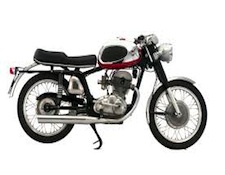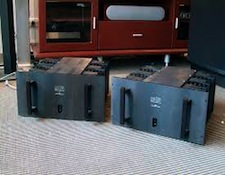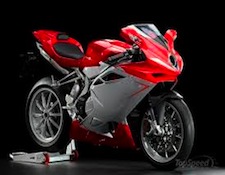It’s the time of year for saving money!
When I was a kid, we would often go to the Sunset Strip on a Saturday night and spend our time “window shopping” at an exotic car dealership (Sorry, I don’t remember the name) that could always be counted on to have truly wonderful stuff. At one time, it even had TWO (count ’em) O.S.C.A.’s – an Italian sports car brand that, until then, no one had ever seen even ONE of — for us to admire and lust after. One time, we went there and, in the showroom window, was a tiny (as such things go), beautifully-painted, sleek, exotically-styled and absolutely gorgeous MV Agusta motorcycle.
Smitten with it, I called the dealership on the following Monday and asked what it was and how much it cost. The salesman said he didn’t really know; that their specialty was cars and not bikes; that he would have to check with the dealership’s owners to get the information I wanted; and that I should call back tomorrow. When I did, he told me it was a single cylinder 250, new, but model year unknown, and quoted me a price that, if I never ate or bought anything else ever again, I might actually have been able to pay. Excited, I asked about its speed and horsepower, and was again told to call back tomorrow, when he might have the bike’s Owner’s Manual at hand and be able to answer more of my questions.

When I did that, he told me that its top speed was unstated, but that the manual (which was in Italian) specified an output of just fourteen horsepower.
I was crushed. Just from its lines, its exotic brand name – especially as depicted in what I still think is one of the most beautiful logos I have ever seen – and its stratospheric pricing, I had expected it to be some kind of ferocious screamer, and here – even as compared to other 250 singles – it turned out to be little more than a glorified putt-putt
When I told the salesman of my disappointment, he said something that I will never forget: “Ah, but those are fourteen ITALIAN horsepower,” he gushed “so the bike is undoubtedly quite potent!”

And that gets me, finally, to the subject of audio. Do you remember the 25 Watt Mark Levinson ML2 amplifiers? Or the 25-watters from Classe? Or, if you prefer tubes, do you remember any of the exotic, very low-powered tube amps, all using 300Bs or something even more exotic; all viciously expensive; all built with equally exotic hand-rolled capacitors and hand wound transformers and wired with silver or secret alloys or (it wouldn’t surprise me) the pubic hair of virgins; and at least many of which claimed to have been hand-built in Japan by golden-eared Samurai lords, working in silence in the courtyard of a Shinto temple under the light of a blue moon?
Do you remember hearing that whatever few Watts they produced were supposed, somehow, like “Italian horsepower”, to be much more powerful than the numbers would indicate? Well, guess what? “Watts is Watts”, and low-powered amplifiers are low-powered.
That’s not to say that they don’t SEEM otherwise, but what makes them seem that way is nothing mystical, it’s just the surprisingly small amount of power that it actually takes to drive a loudspeaker to respectable volume.
Volume level – and thus the apparent output power of an amplifier – is tricky. In the first place, it’s a logarithmic, rather than linear function, which means that twice as much output to your speakers ISN’T going to sound twice as loud! In fact, for what you’re listening to to SEEM twice as loud requires TEN TIMES as much power! By the same token (Tolkien, if you’re a Hobbit fan), it takes only ONE-TENTH as much power to sound half as loud. Knowing that, let’s now take a look at how much power we really listen to most of the time, and use that as a basis for understanding why a low-power amplifier can seem to give high-power performance. Many of the loudness figures cited here will be from this chart, compiled by Galen Carol Audio.
To get started, let’s assume that we have a loudspeaker of about average sensitivity (87dB at 1 Watt/1 meter) and that we have (just to prove the point even better) a large listening room, in which we will be sitting a full 4 meters (13.12 feet) from our speaker. (Even though we will, most likely be listening in stereo through 2 speakers, the following calculations, to make things simpler, all assume just ONE speaker.)
According to the chart, the average loudness level of a conversation between people 3 feet apart is 60-65dB so, if we want our music to be, on average, TWICE as loud as a loud conversation, we’re going to need a level of 75dB AT OUR LISTENING POSITION. Because our speaker will make 87dB at 1 Watt/1 meter, and 75dB is 12 dB less than that, we’ll only need 0.0625 Watts of power to produce 75dB at a distance of 1 meter from the driver(s). We’ll be sitting 4 times farther away, though, at 4 meters from the speaker, so, assuming that the speaker’s directivity (its dispersion pattern at frequency) is such that the “inverse square rule” applies, it’s going to take 16 times as much power – one Watt — to get the volume up to 75dB at our listening position.
Yup, that’s right ONE WHOLE WATT to play at TWICE the level of a (loud) conversation – EVEN IN A BIG ROOM, and only a total of 10 Watts to play twice as loud as that! When you consider that there are speakers out there (horns, mostly) that will make more than 100 dB at 1Watt/1meter, and that even a “little” amp, like the ML2 or the Japanese luxury tube jobs, may have 25, , it becomes not at all unlikely for a low-powered amplifier to sound like it’s got a lot more “grunt” than it really does. It’s NOT that one kind of Watt is more powerful than some other kind of Watt any more than an Italian horsepower is any more potent than one from some other country.

Incidentally, that MV Agusta 250 with the 14 horsepower probably had a top speed of around 72 MPH. By contrast, MV Agusta’s current top-of-the-line model has nearly 200 horsepower and a top speed of around 200 MPH (323 KPH). When you’ve got that much power and a total vehicle weight – including rider – of under 600 pounds (273 kilos), the whole issue of whether or not Italian horsepower are “bigger” becomes moot: They don’t need to be!





